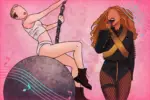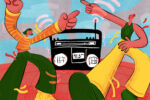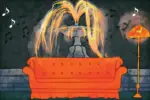June 16 marks the 50-year anniversary of this rock ‘n’ roll classic, and it seems like a fantastic opportunity to go over its effect on music and culture as a whole.
David Bowie was a man of many talents; he was a musical chameleon creating hit singles nearly every decade of his career and acting in movies and on stage. His fictional stage characters have spread fear, joy, ecstasy and confusion among audiences — making him one of the most polarizing figures in music history.
“The Rise and Fall of Ziggy Stardust and the Spiders from Mars” is a part of several notable phases in Bowie’s career. In the early to mid-’70s, Ziggy Stardust was considered the pinnacle of Bowie’s glam rock era, which also encompassed albums such as “Aladdin Sane,” “The Man Who Sold the World,” and “Hunky Dory,” the album that directly preceded this one. One track on “Hunky Dory” that is vital to note, considering the themes of “Ziggy Stardust,” is “Life on Mars?”
At this point, Bowie had long been obsessed with space as a theme in his art. His big break-out single was “Space Oddity” — released five days before the Apollo 11 launch in 1969, which told the story of astronaut Major Tom getting lost in space. But “Life on Mars” isn’t so much about life on Mars. Instead, it uses Mars as an escape or an idea of an escape from the mundane struggles and cliched commercial art of planet Earth. A song that makes such a significant statement should be wrapped in lavishly grand instrumentation. Bowie explores these themes of rock ‘n’ roll, space and fame through these ambitious instrumentals and inventive characters.
With “Ziggy Stardust,” Bowie finally created an album that garnered attention from both critics and the general public. While it is not as heavy, punchy and instrumentally crisp as the follow-up album, “Aladdin Sane” (which was dropped just a year later), it’s the themes and concept of “Ziggy Stardust” that makes this album such a seminal record for Bowie.
The Album
The record kicks off with beautiful piano and some dramatic vocals from Bowie, and it includes a storyline that sounds like it’s ripped straight out of a sci-fi movie. The Earth is dying, and it has five years left to live. “Five Years” has a gentle groove with beautiful piano and string crescendos that become dissonant and chaotic at the end, with Bowie’s vocals shouting and going crazy. The lyrics possess a rush of nostalgia, like Bowie’s life is flashing before his eyes as he thinks about all the things that he’s going to miss: “I saw boys, toys, electric irons and TVs.”
Despite being mundane objects, he feels like he needs to stash the items away in his mind. Bowie compares his mind to a warehouse where he needs to cram everything because it’s all literally about to become erased from the face of the Earth. The entire track is a mural with numerous characters and objects. It’s a beautiful open to the record and gives the album a gloomy tone. However, the collection swiftly deviates from it once the song “Soul Love” pops in.
It’s a beautiful love song that’s sensual and smooth. Bowie’s odd and doubled singing voice on the track almost sounds like he’s an alien beaming down from another planet to deliver a message of peace and love. It’s set to some saxophone, springy hand percussion and tiny acoustic guitar. While it is a love song, it avoids a lot of the cliches love songs of the day share because Bowie sings about it in an abstract and philosophical sense: “Inspirations have I none, just the touch the flaming dove/ All I have is my love of love, and love is not loving.”
The next song, “Moonage Daydream,” is a little more eventful because it gets back into the narrative of the record, and it features punchy guitars and loud blaring drum fills. In a sense, this track introduces the character of Ziggy Stardust, even though the song predates the album. Still, Bowie portrays himself as a “space invader” who leaves quite the impression on Earth’s population. He gives the impression of someone wanting to be the center of attention — especially when the chorus comes around and he says, “Keep your electric eye on me.”
Based on the narrative of the song, Ziggy is supposed to come down and save the world from this five-year oblivion. Still, the track and the album itself are more of a statement about fame and attention. There are other interpretations that people can pull from this track, but the attention and fame narrative becomes more and more apparent as the album progresses. The instrumental and guitar solo passage are fantastic, the psychedelic effects on the vocals are lovely, the strings get wild toward the end of the cut and the horns and flute passage in the middle of the track are beautiful.
In a way, Bowie portrays himself on this track as an artist or a figure who could make a real impact on society if he had the platform and opportunity. That feeling is confirmed in the song “Starman,” where Bowie sings, “there’s a Starman waiting in the sky” and “he’d like to come and meet us.” However, the Starman worries that if he exposes the world to these new ideas and sounds, “he’d blow our minds.” In his art, Bowie tells us that he feels like he has something unique to offer that will leave a mark on musical and artistic history. Perhaps it’s this mark that Bowie has given us that has saved the world from this five-year peril.
The song “It Ain’t Easy” deviates from the album’s narrative. The track is a cover song of a Ron Davies track dropped in 1970, a soulful country song with a plucky acoustic guitar intro. Bowie’s rendition is much heavier and has a yelping vocal delivery.
Getting into the song “Lady Stardust,” Bowie comments on the idea of image, especially as it relates to glam rock and specifically Marc Bolan of T. Rex, who the song references. Bolan was notorious for his performance makeup, long black hair, and, like Starman, an artistic rock ‘n’ roll persona that baffled closed-minded people. In a way, Bowie comments on the new wave of expression in rock music and how the public interprets it.
Bowie dives directly into the idea of rock stardom in the song “Star.” Lyrically, Bowie portrays a rock star as something to mutate into, which is something he wants and needs. By the end of the track, Bowie states: “I could fall asleep at night as a rock ‘n’ roll star/ I could fall in love all right as a rock ‘n’ roll star.”
The song “Hang on to Yourself” isn’t one of the more lyrically intriguing additions, although, there is a direct reference to the Spiders from Mars — Ziggy Stardust’s backing band. The following song, “Ziggy Stardust,” doesn’t valorize the fictional frontman; rather, Bowie explores stardom in-depth as he describes how Ziggy Stardust’s fame has poisoned him. By the end of the cut, he’s sucked up into his ego, and the band breaks up. As Bowie sings in the song, “he’s taking it too far.”
The following track, “Suffragette City,” again deviates from the narrative as Bowie sings about the women’s suffrage movement of the early 1900s. Featuring booming guitar riffs, percussion, saxophone-like synths and piano, the song was initially meant to be given to the band Mott the Hoople, whom Bowie was very fond of.
This eventually leads to “Rock ‘n’ Roll Suicide,” which ends the album. It’s an exhausting reflection on a life well-lived. It opens with the phrase, “Time takes a cigarette, puts it in your mouth / You pull on your finger, then another finger, then your cigarette,” which speaks to how time can wear one down and force one into substance abuse. Bowie has portrayed stardom and fame as beautiful things for most of the album. But the star that has risen now needs to fall.
Bowie seems to sit in a calm state of reflection as he looks back on memories of his youth — stumbling home after late nights, trying to avoid the sun and ignoring the sound of the milk truck signaling morning. It’s Bowie’s boyhood, but it’s also the experience most people have had in their adolescence.
Bowie is not only reflecting on his own life; it feels like an intimate conversation between him and his devoted fanbase. Bowie sings that he was hard on himself, wishing he could show his younger self all he knows now. It’s a plea to remember all you have around you, no matter how the darkness claws at your mind. Bowie understands and emphasizes that he’s had his share and now wants to help his listeners, audience and his younger self. It ends with a triumphant momentum of love and acceptance: “Just turn on with me and you’re not alone / Give me your hands ‘cause you’re wonderful.”
As Ziggy Stardust reaches his final moments, he looks outward to those he touched, leaving them with a message of hope. It is an epic curtain close as it feels like the spotlight is solely on the character played by Bowie. It feels like one is listening to a grand theatrical stage show when he’s singing. Many artists played characters who told great stories in their songs over the years. However, Bowie, more than any other artist, embodied this sense of drama and theater in his music to the extreme. More than any other in his whole discography, this track represents that.
Comments on Fame
Many similar meta-references to fame are being repeated by countless rock stars and rappers today. Artists like Kanye West, Drake and Kendrick Lamar are essentially rapping about their fame and how it’s not all it’s cracked up to be. What’s funny is that some of these statements in Bowie’s music are so subtle and buried in hooks, choruses and instrumentation that you might miss them unless you were looking for them. So, to people who may be familiar with this album and love the sound of the record, the next time you’re listening, dive a little deeper into what Bowie is saying and think about the historical context.
Effect on Culture
While the music is phenomenal, it’s the stories around the character of Ziggy Stardust and how it affected culture and Bowie that is perhaps the most intriguing. One has to consider the themes on the album and in glam rock in general that dealt with homosexuality, because glam rock was home to many superstars who were gay, bisexual or used the characters they would play onstage to bend gender.
What’s so interesting about this record is how popular it still is. Of course, it is mainly attributed to the beautifully wonderful and fantastically produced music of the album and its lavish instrumentation. However, a deep dive into the album reveals lyrics that are very dated; the type of stuff that Bolan and Bowie were doing back then wouldn’t turn any heads today.
Still, one has to think about how close-minded many people were back in the ’70s, who not only rejected homosexuality outright but also spurned performances from the likes of Bolan and Bowie that merely alluded to it. The modern equivalent might be similar to Lil Nas X or Harry Styles.
Ziggy Stardust would quickly become Bowie’s onstage persona and the person he became in interviews. In regards to his purposely ambiguous sexuality, Bowie seemed hell-bent on challenging everything in music and culture as a whole. At shows, he would often strip down to nothing but a loincloth on stage and simulate somewhat risky acts on the guitar with Mick Ronson.
This led to countless rumors about David Bowie’s offstage life and many conservative groups warned about the ills of the album. From the iconic outfits of Ziggy Stardust to the wild dyed hair he presented, Bowie completely rewrote the book on what a rock star was allowed to look like — inadvertently giving an entirely new image and style to the glam rock movement. From the New York Dolls to Lou Reed‘s “Transformer” to countless other bands and albums, they all led back to Ziggy Stardust.
In interviews well after the fact, Bowie admitted that he threw himself deeply into the character of Ziggy Stardust and he had a great deal of difficulty separating himself from the persona. Bowie said that Ziggy Stardust almost haunted him when he wasn’t on stage, even years following the tour.
Life truly began to imitate art on the “Ziggy Stardust” tour, with the legendary final performance captured for a documentary that bears the same name as the album. In Bowie’s last show of the tour, he announced that it would be his last performance. In the short 13 months that Ziggy Stardust appeared live on stage, he forever altered the entire world of culture. His blatant sexuality and over-the-top persona would open the door for countless new bands, sounds, social movements and other aspects of popular culture.
Fifty years after its release, no album has even come close to the power of “The Rise and Fall of Ziggy Stardust and the Spiders from Mars” or the iconic stage persona that was Ziggy Stardust.
















